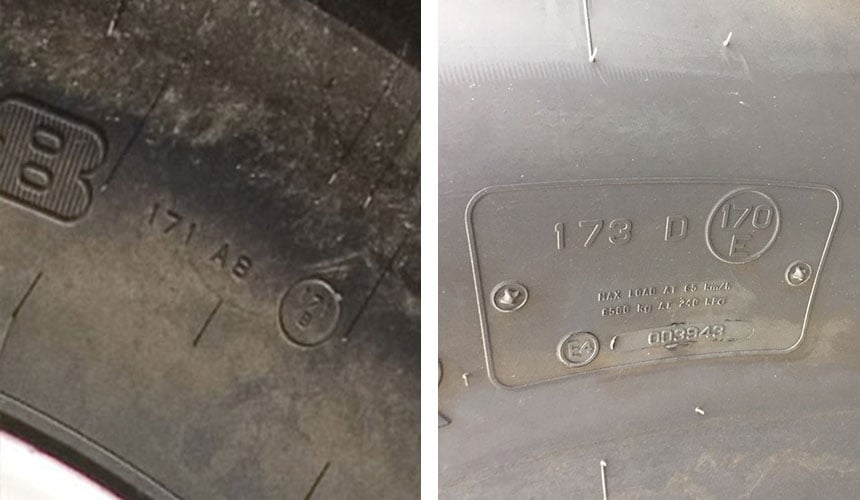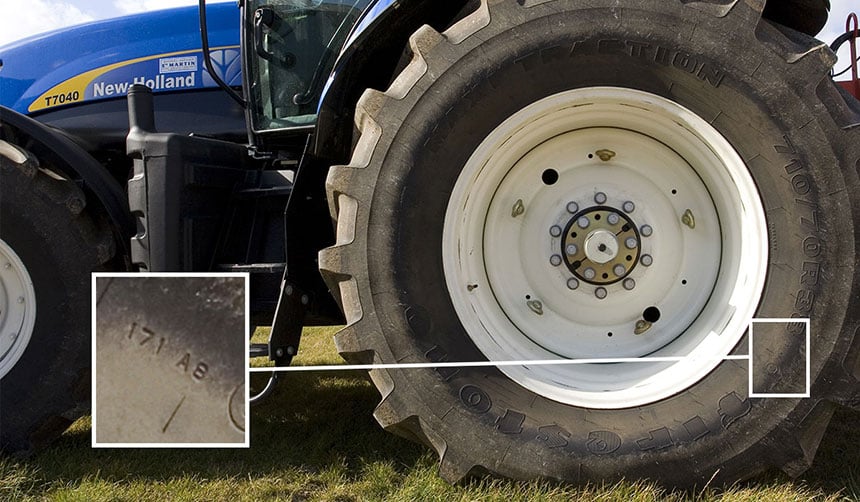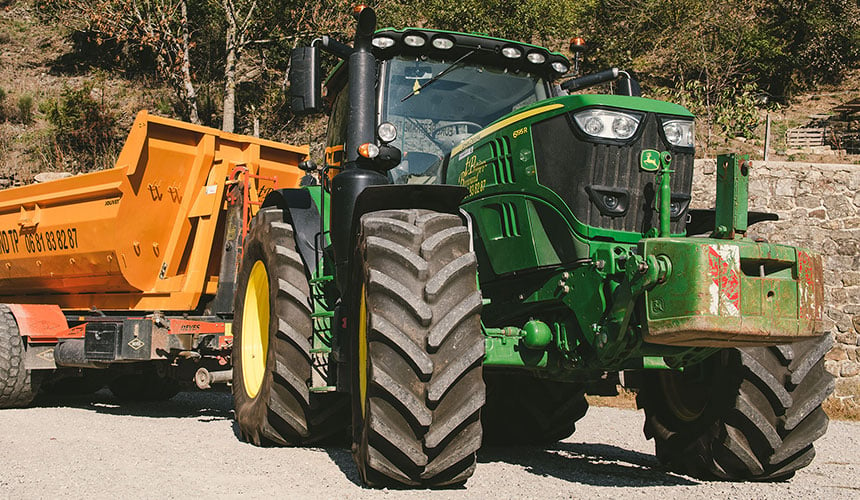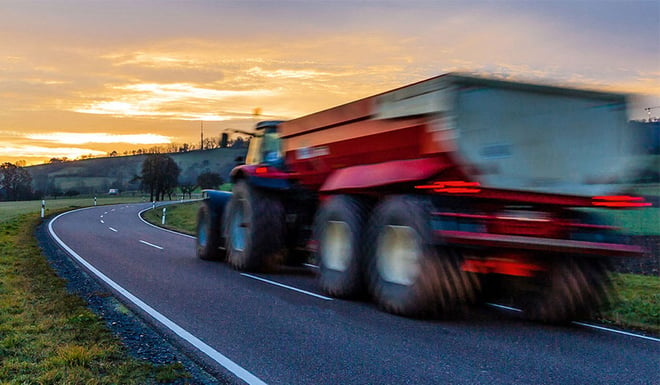Your tractor tyres were designed and tested to correspond optimally to a very precise use, unlike other vehicle tyres (car, motorbike….).
You are going to put them severely to the test during your daily work and you would like them to be indestructible, solid, supple, long-lasting and multi-resistant. High quality tyres have been tested for use on all types of terrain during unladen trips and during periods when your tractor and trailer are fully loaded, and this is where the importance of the speed index comes in.
With an agricultural tyre, the load capacity may be multiplied by 1.5 or even 2.
EXAMPLE: for a 900/60 R42 180D tyre
| Pressure: 2.4 bar Speed: 65 km/h |
Load capacity = 8,000 kg. |
| Pressure: 2.4 bar Speed: 10 km/h |
Load capacity = 12,000 kg, i.e. 50% more |
As far as increases in load capacity are concerned, you can increase the load coefficient, but this must be on an exceptional basis only and there are of course operating constraints in this case.
There is an appropriate speed at which you can drive laden in perfect safety.
Here are some details and explanations to help you understand better what the speed index is for
WHAT HAPPENS IF YOU DO NOT TAKE ACCOUNT OF YOUR TRACTOR TYRES’ SPEED INDEX?
Quality agricultural tyres are designed to resist intensive use in the fields and on the road. Nonetheless, they have a limited lifespan and their durability depends on several factors linked to the conditions in which they are used, in particular load, inflation pressure and speed. These factors have an influence on the resistance of the rubber with which your tyre is made, and as such on its wear.
To be able to use your tyres for the longest length of time possible, it is recommended that you stick to the speed index recommended by the manufacturer.
If you go beyond this limit, the layer of rubber used in your tyre tread may deteriorate rapidly as a result of the excessive heating linked to speed. This inevitably leads to the destruction of the interior structure of the tyre, obliging you to stop work and replace the tyre immediately.
On the road, it is advisable to reduce your speed, in particular when your tractor has a heavy load, during harvesting for example. By doing so, you put less pressure on the tread of your tyre, which will limit heating and alteration of the rubber.
WHAT IS THE SPEED INDEX?
Defined by the manufacturer, the speed index or speed symbol corresponds to the maximum speed when loaded. It’s a question of the balance between the tyre’s load capacity and the tractor’s driving speed which makes it possible to preserve the material components of the tyre and ensure its use on a long-term basis.
Like all the other information relating to the characteristics of agricultural tyres (origin, size, load index…), the speed symbol can be found on the sidewall of your tyre. In general, it corresponds to a letter or a letter and a number, and is indicated after the load index.

In relation to the load index, the speed index is used to designate a speed category from the list below. To find out the maximum speed at which your agricultural vehicle can drive loaded, refer to the following speed rating table:
| SPEED INDEX | SPEED (in km/h) | SPEED INDEX | SPEED (in km/h) | |
| A1 | 5 | B | 50 | |
| A2 | 10 | C | 60 | |
| A3 | 15 | D | 65 | |
| A4 | 20 | E | 70 | |
| A5 | 25 | F | 80 | |
| A6 | 30 | G | 90 | |
| A7 | 35 | etc... | ||
| A8 | 40 |
The speed index is associated with the load index to give the optimal performance of a tyre, for example “171 A8”.
171: is the load index, it corresponds to 6150 kilos, the maximum weight that the tyre can bear at up to 40 km/h (A8).
A8: this is the maximum speed with a full load, i.e. 40 km/h.
 If you drive faster than this speed with a full load, your tyres are not used optimally and will not have the same resistance capacity. They could burst over a long distance due to an excessive rise in temperature.
If you drive faster than this speed with a full load, your tyres are not used optimally and will not have the same resistance capacity. They could burst over a long distance due to an excessive rise in temperature.
Failure to comply with this rule will also lead to premature wear as well as the deterioration of the overall structure of your tyres and could even cause an accident when braking if you are really travelling too fast.
With no load, you may drive faster than the recommended speed without any problem for your tyres on condition, of course, that you respect the applicable rules and standard safety regulations in accordance with traffic laws.
To determine the speed index of a tyre, manufacturers have years of research and development at their disposal which allows them to establish accurately the optimal capacity of each tyre while preserving its integrity.
For each model, they carry out a series of tests using loaded vehicles and driving at increasingly faster speeds and then analyse the structure of the tyre after each speed test.
If the tyre withstands the given speed, it is approved for a precise speed index corresponding to a precise load before being placed on the market.
When you decide to buy new tyres for your tractor, pay careful attention to certain details, such as the speed index, because you cannot choose this randomly. For example, it’s not a good idea to opt for a tyre with a lower speed index than the original mount. You can, on the other hand, opt for a tyre with a higher speed index than the original tyre.
IS THERE A SOLUTION FOR NOT HAVING TO WORRY ABOUT THE SPEED INDEX?
Even though quality agricultural tyres guarantee a longer life, they are not immune to natural wear which happens over time. This can be due to the friction caused between the rubber and the ground in your fields, in the farm courtyard or on road surfaces.
Failure to respect the speed index indicated by the manufacturer can also cause the premature deterioration of an agricultural tyre.
There are several solutions to extend the life of your tyres:
1. Maintain your tractor and adjust its settings regularly
2. Adjust tyre inflation to work at the right pressure depending on the type of activity and the load
3. Store tyres in an appropriate place when not used
4. Adapt your speed when carrying heavy loads.
If you use standard tyres, it is essential that you respect the maximum speed limit recommended by the manufacturer when loaded to avoid damaging your tyres rapidly, especially if your agricultural activities are multiple:
- Travel by road
- Intensive use in farmyard areas
- Work in the fields with or without a trailer, etc.
Another alternative: equip your tractor with IF or VF agricultural tyres
IF or VF tyres allow you to drive in complete safety without worrying about the speed index, even if your tractor is loaded. IF (Improved Flexion) and VF (Very Improved Flexion) tyres can bear a much heavier load than traditional radial tyres. Furthermore, they were designed to carry very heavy loads, whatever the speed at which the tractor is travelling.

In detail, these last generation agricultural tyres are the most sought after low-pressure tyres in terms of performance and efficiency. Manufactured using special materials, they have an extensive flexion capacity in the sidewall. The IF casing allows you to increase the tyre’s load capacity by up to 20% and the VF tyre by up to 40%. Whatever the model you choose, your tyre will have a greater tractive force while reducing fuel consumption, particularly when working in the fields.
One of the main specificities of these innovative tyres is that they are manufactured with a reinforced casing which allows them to be used in the fields at very low pressure. Studies have effectively shown that they can be used at a pressure of as low as 0.8 bar.
The deflection of the tyre spreads the weight of the tractor over a larger surface area on the ground, which preserves your crops and therefore your yields.
By opting for IF or VF agricultural tyres, you won’t have to worry any more about adjusting tyre pressure between the fields and the road. In addition, these tyres can travel at speed on the road with the same pressure as in the fields, while improving user comfort. Unlike a traditional casing, the IF tyre can bear a heavier weight at high speed and/or high pressure according to the manufacturer.
The Bridgestone-agriculture.eu blog is written and administered by tractor tyre experts who are available to provide you with the advice you need on the subject of your agricultural tyres. They allow you to maximise your productivity with information on all subjects linked to tyres: Cheap tractor tyres — Technical data for agricultural tyres — Air pressure advice — Solutions to avoid soil compaction — Sprayer tyre pressure — Why and how to ballast your tractor tyres — When to use dual wheels — The mechanical causes of abnormal wear — Cheap agricultural tyres – etc…
To learn more and boost your farm's profits, Bridgestone-Agriculture is offering you a free, detailed white paper that explains the essential role your agricultural tyres play in your productivity.
Most people who read this article have also read some of the following articles:
This information is intended only to make you aware of the technical and functional aspects of agricultural tires and their use. It does not allow you to make a judgment or a definitive conclusion on a given problem. Only your agricultural tire expert is able to make a technical assessment and take a final decision, case by case.
Leave a
commentary
Your email address will not be published.
Required fields are indicated with *








